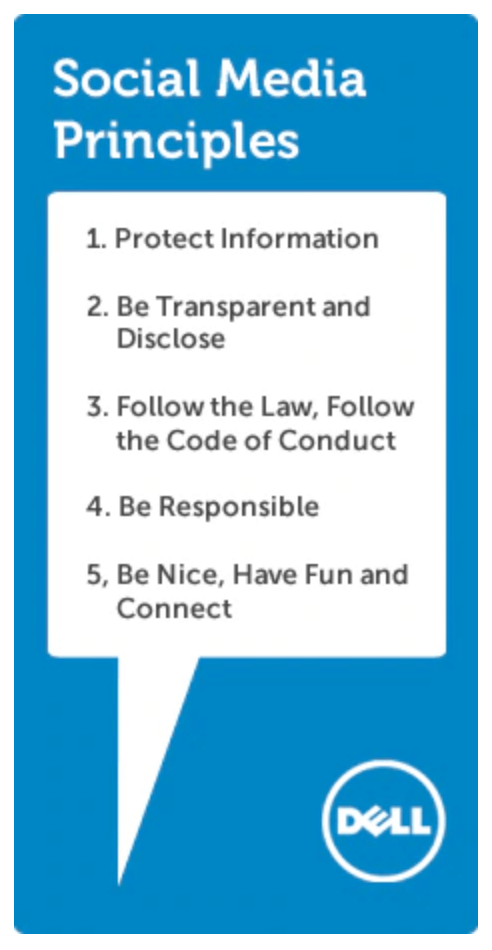
By Kerry Gorgone, {grow} Contributing Columnist
Social media policies for brands was a hot topic of discussion five to ten years ago, but not so much today. You might wonder: are they even still a thing? The short answer is yes, and are more important than ever.
The purpose of a social media policy is to let employees know how they should (and should not) communicate on social channels. These guidelines may relate to who can use official social accounts, what can be shared, and the language and terms to use, but other social media policies apply to employees’ personal use of sites like Facebook, Twitter, and Instagram.
Ultimately, these policies are meant to protect companies, but they can also empower employees.
Update your social media policy
If you’re thinking about restricting employees’ use of social networks, don’t bother. Not even political arguments can keep people off sites like Facebook, it seems, because U.S. adults are using social media just as much in 2019 as they did in 2018.
More than 90 percent of Millennials use some form of social media compared to 48% of Baby Boomers. So, with more Millennials entering the workforce as Baby Boomers retire, the average worker is more likely to be a regular user of a variety of social apps.
Moreover, it would be hypocritical to restrict usage when recruiters are using social to find new employees. One survey found that 84 percent of organizations use social media for recruitment.
So, with social media usage as widespread as it’s ever been, social media policies remain relevant.
The new priorities
“Every brand… should have a social media policy,” advises attorney and social media legal expert Sara Hawkins. “Not only do they establish the expectations the company has when it comes to employees posting on social media, it gives employees an understanding of the type of monitoring they could be subject to.”
In Hawkins’s view, these policies are especially valuable if companies expect employees to regularly promote or advocate for their business online.
While there is no standard set of requirements for a social media policy, Hawkins recommends companies cover these topics:
- Websites that are prohibited during work hours or when using company property
- Limitations regarding what can be shared, with the goal of protecting confidential information and employee privacy
- Security protocols to safeguard company information and address the use of company email addresses for social media logins
- Guidelines for brand advocacy and disclosure of employee status
- Address legal precautions specific to your company or certain roles, such as HIPPA, FTC, and financial disclosures
- Reporting procedures and consequences
Keep it simple
Hawkins adds that no social media policy can work unless you plan to monitor social media activity and provide some kind of oversight. This should be an essential part of any social media strategy.
However, if you want your social-savvy employees to actually read and adopt your policy, don’t write it like a “Terms & Conditions” page filled with legal jargon.
Social media policies should resemble your best marketing content.
1. Write in a conversational and readable style.
 Dell’s social media policy reads like it was written by an actual human and not a lawyer. It’s very clear and simple to understand, with five established principles and descriptions that help empower their employees (who won’t need a law degree to understand what it means for them).
Dell’s social media policy reads like it was written by an actual human and not a lawyer. It’s very clear and simple to understand, with five established principles and descriptions that help empower their employees (who won’t need a law degree to understand what it means for them).
2. Include examples.
It’s also helpful to provide real-world examples or scenarios to help employees understand your expectations. In Adidas’ social media policy, they ask its employees to consider the consequences of their social media activity. They describe a scenario in which a coworker tweets about how one of your products “completely sucks,” and how awkward it would be to have a client see and point out that post in a sales meeting. Through the use of similar examples, you can help workers understand the value of each policy.
3. Get specific.
And when in doubt, include specifics so your employees know the language, subject matter, and even branding they should use or avoid. “Have a list of items that are strictly prohibited,” Hawkins recommends, “such as harassment, bullying, racial slurs, sexual content, and even use of company logos so that employees know clearly when certain lines have been crossed.”
In the case of General Motors, the company asks that employees disclose their identity by including the hashtag #IWorkForGM whenever they post about their company or industry.
Lastly, social media policies should provide helpful guidance for every employee now and in the future. Consider your policy a living, breathing document that reflects your brand values, as well as the state of social media. With that in mind, make it a point to review and update your policy every 6 months. You might even want to review your policy every quarter if it refers to information that could quickly become outdated, like links to specific social media platforms.
Use a social media policy to empower
The bottom line: we want our socially savvy employees involved, especially experienced colleagues who could teach the rest of us about new trends, platforms, and ways to promote our brand.
Use your social media policy to empower your social butterflies, creating helpful guidelines rather than restrictive rules, and you’ll pave the way for employees to express themselves without reflecting badly on your brand.
 Kerry O’Shea Gorgone is a writer, lawyer, speaker and educator. She’s also a Learning Designer at MarketingProfs. Kerry hosts the weekly Marketing Smarts podcast and gets people to open up about their cool collections, weird hobbies, and inspiring side hustles on Punch Out With Katie and Kerry with co-host Katie Robbert. Find Kerry on Twitter.
Kerry O’Shea Gorgone is a writer, lawyer, speaker and educator. She’s also a Learning Designer at MarketingProfs. Kerry hosts the weekly Marketing Smarts podcast and gets people to open up about their cool collections, weird hobbies, and inspiring side hustles on Punch Out With Katie and Kerry with co-host Katie Robbert. Find Kerry on Twitter.


